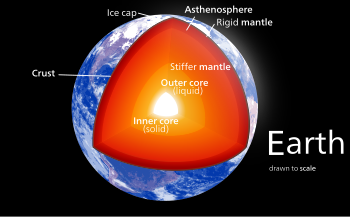
Earth's mantle is a layer of silicate rock between the crust and the outer core. It has a mass of 4.01×1024 kg (8.84×1024 lb) and makes up 67% of the mass of Earth.[1] It has a thickness of 2,900 kilometers (1,800 mi)[1] making up about 46% of Earth's radius and 84% of Earth's volume. It is predominantly solid but, on geologic time scales, it behaves as a viscous fluid, sometimes described as having the consistency of caramel.[2][3] Partial melting of the mantle at mid-ocean ridges produces oceanic crust, and partial melting of the mantle at subduction zones produces continental crust.[4]
- ^ a b Lodders, Katharina (1998). The planetary scientist's companion. Fegley, Bruce. New York: Oxford University Press. ISBN 1-4237-5983-4. OCLC 65171709.
- ^ "PDS/PPI Home Page". pds-ppi.igpp.ucla.edu. Retrieved 2021-01-29.
- ^ "In Depth | Earth". NASA Solar System Exploration. Archived from the original on 2021-02-12. Retrieved 2021-01-29.
- ^ "What is the Earth's Mantle Made Of? - Universe Today". Universe Today. 2016-03-26. Retrieved 2018-11-24.